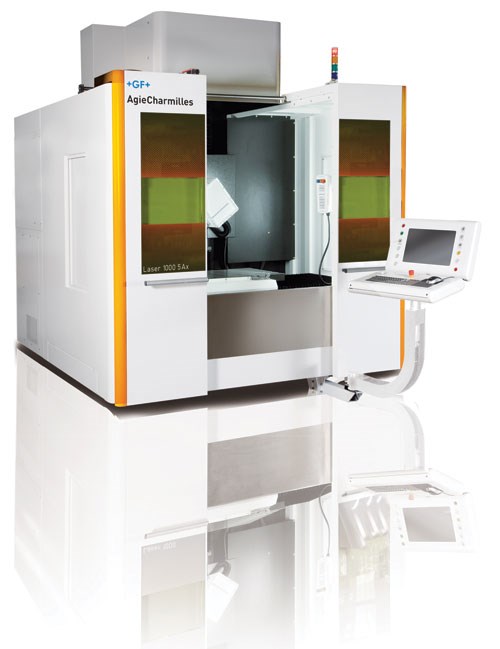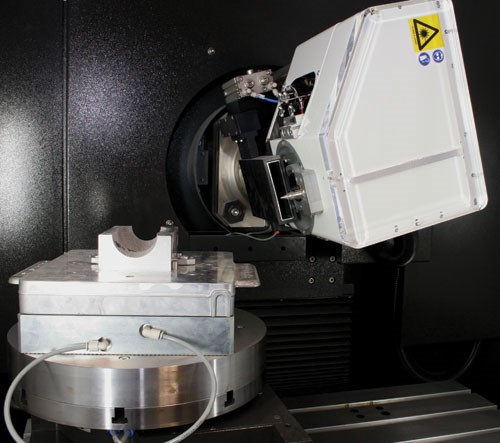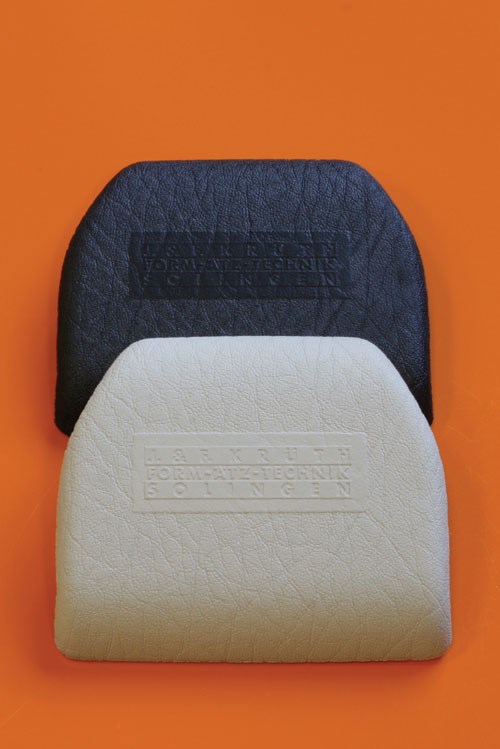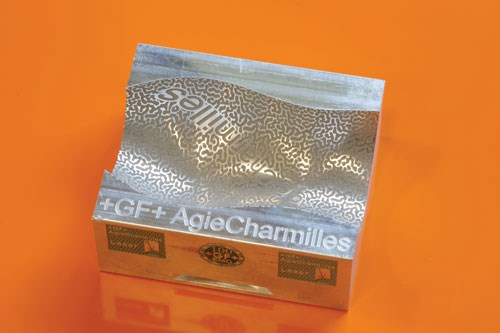
A laser ablation system.

Inside the work area. A pulsed ytterbium
fiber laser—20 or 50W—is used for ablation.

Textured parts produced via
laser ablation. (Source: J. & F.
Krüth GmbH, Form-Ätz-Technik)

Aluminum tool textured with
laser ablation; processing time:
1.5 days. (Source: J. & F. Krüth
GmbH, Form-Ätz-Technik)

Blow molding tool that’s both
textured and engraved.
Previous
Next
Related:
Automotive Production
Related Suppliers
-
GF Machining Solutions
Although the interiors of premium German cars have long been benchmarks, conceivably the quality level within some of those vehicles is going to be getting even better soon. That’s because, says Gisbert Ledvon, business development manager, GF AgieCharmilles (GFAC; gfac.com/gfac.html , a producer of laser ablation equipment (as well as a range of other products used to manufacture high-quality molds and dies, including electrical discharge machining (EDM) equipment and precision milling machines), a few years ago suppliers for some of the German builders bought laser ablation equipment to produce tooling for interior components, and given the roughly three year lead-time, those vehicles are about to hit the streets.Â
“Laser ablation†is a process through which a metal is sublimated, or goes from a solid to a gas without the intermediate step of a liquid form (as in melting). The laser ablation performed by a GFAC machine is done with a pulsed ytterbium laser with a power of 20 W or 50 W. The spot size ranges in diameter from 30 to 70 microns.Â
The laser is guided by a program that is based on digital input, be it a CAD model of the texture to be achieved or a 3D scan of a physical model of the desired surface. Thanks to the use of the digital model, there is a high degree of consistency—a higher degree, Ledvon says, than can be achieved via the common method of using chemical etching for creating the surface texturing on molds and dies used to produce interior components ranging from trim pieces to instrument panels. This is particularly the case when there are multiple molds involved in producing a given component due to the variability from the texture that can be produced on each of the molds, as analog methods aren’t as repeatable as digital. In addition to which, there are differences predicated on the process parameters of the chemical etching process (i.e., unless each of the components is in the chemical solution for precisely the same amount of time, there will be variations in the degree of etching).Â
Because the laser processing is highly deterministic (i.e., it is driven by the digital model; the laser makes a series of spots of the same size and depth on the surface based on the program) variation is essentially nonexistent.Â
Consider, for example, instrument panels where there is a door cut out for the passenger airbag. As those are two different parts, it is often the case that the texture on the tools is slightly different between the large piece (the panel) and the smaller part (the door). Ledvon points out that in some cases, larger part textures are produced through the use of chemical etching while the molds for some smaller parts are made with EDM, which results in a different texture. If vehicle manufacturers are looking for consistency across the 3D surfaces, then the pulsed laser processing is the way to achieve it because the same pattern can be produced on each of the tools.
Preparing a surface for chemical etching is labor intensive. This is because the foils and films used in the process must be precisely aligned and located. But the chemical etching process is much quicker at removing material than laser ablation. This is most notable in cases where the surface area to be addressed is large.
So some companies, Ledvon says, are using a combination etching-ablating process, one that minimizes the direct labor of the etching process and optimizes the amount of time required to perform the texturing. The surface of the mold is spray painted. Then the laser ablation system is used to remove the paint, exposing the steel as required for the texturing.
However, there are cases where there needs to be the utmost precision in details and features—again, think of  the interiors of high-end German cars—and Ledvon maintains that to achieve, say, a stitching pattern on a surface there is no alternative to the laser ablation technique.
Another advantage of the laser approach is that it permits far more layering of the texture on the surface than is possible otherwise, as many as 50 layers. This means that the surface produced is far richer in 3D appearance.
In addition to providing visual grains on instrument panels and center consoles, there is an additional interior use. Knobs and buttons can be produced with a distinctive texture. Plastic can feel like satin, Ledvon says.
GFAC offers five laser ablation machines, starting with the LASER 500, which offers three axes of laser processing (X, Y, Z axes= 500 x 405 x 82 mm) to the LASER 1200 5Ax (X, Y, Z axes= 1,200 x 900 x 1,200 mm), which also provides a rotary B-axis to move the part and a tilting A-axis for the laser head, thereby making it capable of performing 5-axis laser ablation. (Maximum part size for the LASER 1200 5Ax is 700 x 700 x 700 mm).
According to Ledvon, the people at vehicle manufacturers who have shown the greatest interest in the laser ablation process are not engineers but designers: “When they see what can be achieved . . .â€
______________________________________________
Â
Need to Know
• Laser ablation uses a pulsed laser to vaporize metal on the surfaces of tools and molds
• Using a 3D scan or a CAD file, the surface finish generated is precise (the systems from GF AgieCharmilles (GFAC) have linear scales with a resolution of 0.5 μm on all axes)
• The fiber laser source has a life expectancy of >30,000 hours
• Chemical etching fluids present environmental issues
• In addition to automotive interiors, tire manufacturers are looking at laser ablation to provide visual distinctiveness of their products. Headlight mold manufacturers are using it for processing the lamp reflectors.
Â
The Essentials
By using a laser process—laser ablation—to remove metal from the surfaces of molds and dies, a more consistent pattern can be achieved than is possible with chemical etching, which is valuable for producing interior components such as instrument panels and other trim pieces.
Â








